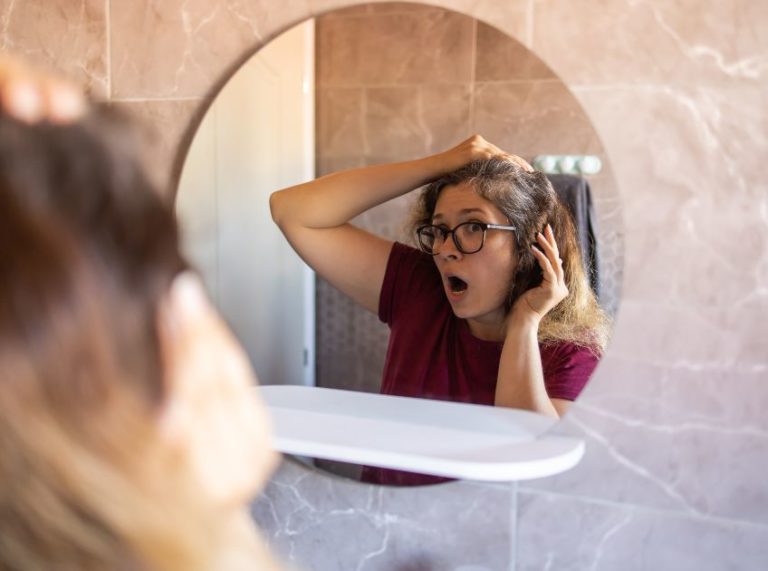
Important: This article is for informational purposes only. Please read our full disclaimer for more details.
Shiny and lustrous hair is everyone’s dream. While some people are born with them, others have to make efforts to achieve the same result. Luckily, there are many products and treatments in the beauty and cosmetic industry that help to bring back the shine and health of hair (1).
Hair gloss and hair glaze are the hair treatments that bring glossiness and shine to dull and dry hair by adding a lipid film (2).
While similar names and almost similar results confuse people about these two, there are some major features that distinguish them. Let’s get a deeper insight into these hair treatments and find out hair gloss vs. hair glaze.
Difference Between Hair Gloss and Hair Glaze
What is Hair Gloss?

Hair gloss is a hair treatment that adds gloss and shine to hair. It is done at the salon by a hair expert and the results are semi-permanent. Besides adding shine, this treatment also helps adhering the color to a recently color-treated hair and prevent the dye to fall dull.
Types
The different types of hair glosses-
- Tinted: For boosting hair color while adding gloss
- Clear: To add gloss to normal and color-treated hair
Clear gloss works more like a top coat that we apply over the nail polish to bring shine to it.
Benefits
- Adds shine and gloss
- Make hair vibrant
- Helps with color maintenance
In hair gloss treatment, a hair mask is applied in the hair for a few minutes and rinsed off. While the normal hair gloss treatment only adds shine to the hair, color gloss makes colored hair more vibrant.
What is Hair Glaze?

Hair glaze is the hair treatment usually done on color-treated hair. It adds shine to the hair and makes it frizz-free. People with dry hair often experience flyaways and frizz, and it is when hair treatments like hair glaze can come to the rescue.
Glaze is an ammonia- and peroxide-free color deposit that is applied to wet hair. It is not a permanent hair treatment. The color deposit sits on the top of the hair and brings the shine (3).
Type
Hair glazes are of two different types-
- Tinted: Maintain hair color while adding shine to the hair shafts
- Clear: Can be used for both- normal and color-treated hair to restore shine
Benefits
- Doesn’t contain any harmful chemical
- Smoothens the hair texture
- Tames flyaways
- Reduces frizz
- Prevents tangling of hair cuticles
Hair Gloss Vs. Hair Glaze
Below is the table differentiating between hair gloss and hair glaze under different categories-
| Feature | Hair Gloss | Hair Glaze |
| Purpose | Enhances shine and smoothness of hair | Adds shine and seals in color |
| Function | Adds a reflective finish to hair | Locks in color and provides shine |
| Application | Applied after shampooing and before styling | Applied after coloring or in between color treatments |
| Ingredients | Typically contains silicone and conditioning agents | Contains a blend of oils, silicones, and sometimes colorants |
| Effects | Provides temporary shine and sleekness | Provides temporary shine and enhances color vibrancy |
| Duration | Lasts for a few days to a week | Lasts for several weeks to a month |
| Color Impact | Generally colorless or transparent | Can be tinted to enhance or maintain hair color |
| Hair Type Suitability | Suitable for all hair types | Suitable for colored or treated hair |
| Maintenance | Requires periodic reapplication | Requires less frequent reapplication |
| Usage | Often used for special occasions or to revive dull hair | Used regularly to maintain color and shine |
While hair gloss works wonders for shifting colors and neutralizing brassiness, hair glaze is all about adding shine to the hair and making them frizz-free and easy to manage.
Hair gloss also helps in blending the grown-out roots to even the color tone while enhancing the hair shine.
Other than how they work, both hair treatments also differ in their longevity. While hair gloss is a semi-permanent solution, hair glaze is not permanent at all. Since the glaze is free of ammonia and peroxide, the result will not last more than a week. On the other hand, the result of hair gloss may last up to 4 weeks.
Both hair treatments are temporary and fade over time.
Hair Gloss Vs Hair Glaze- Which Is Right for You?
When it comes to choosing one, the intent behind the treatment can help you decide. If you want to add shine to your hair for a few days without touching chemicals, go for a hair glaze. The treatment doesn’t open the cuticles and thus is less risky.
On the other hand, if you are looking for a treatment whose results go a little longer, pick hair gloss. It gives a better finish and more color payoff.
Since both the treatments are less intensive than dye or bleach, both are suitable for maintaining hair health while surfing its shine and gloss.
Conclusion
Hair gloss and hair glaze are the hair treatments that make dull and dry hair glossy and shiny. At the same time, they bring more vibrancy to color-treated hair that often gets dull due to various reasons.
Now that we have cleared the difference between hair gloss and hair glaze, deciding what to choose will become easy. However, if you are still in doubt, contact your hair stylist or color expert to know what will suit your hair more and give better results.
Image Source : canva
Related Articles
- 7 Best Shampoos for Hair Smoothening
- How to Straighten Hair with Coconut Milk
- How To Get Rid Of Static Hair?















